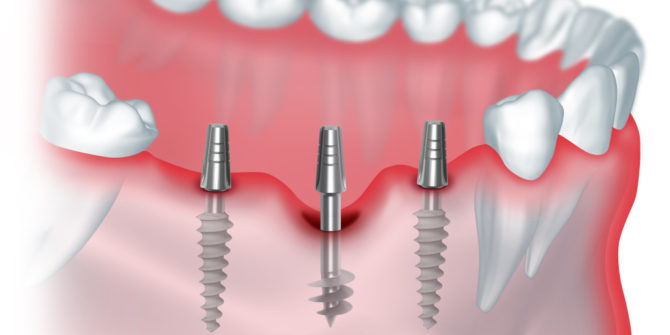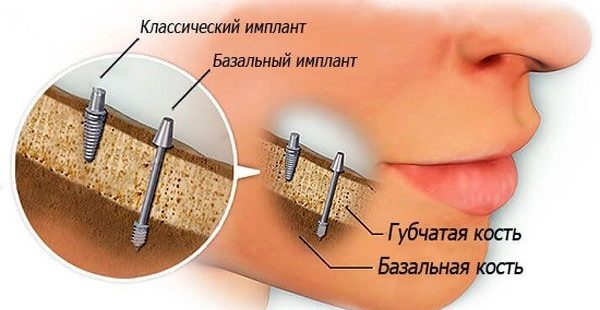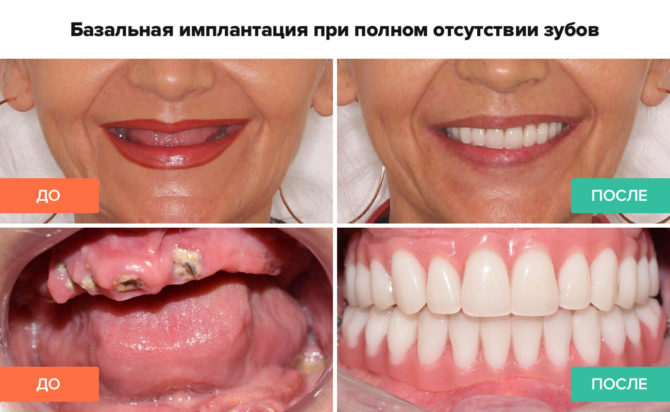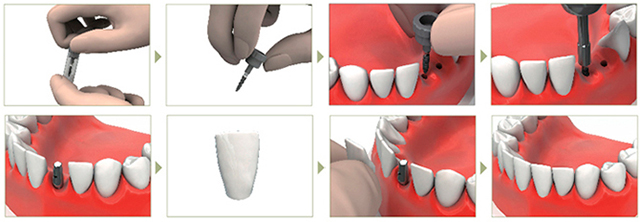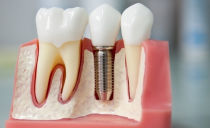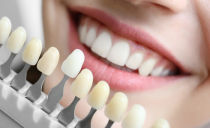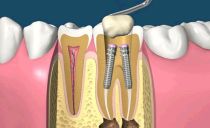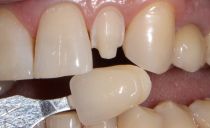Basal implantation: what is it, the pros and cons, stages of the installation of dentures, complications
The use of modern techniques to restore the integrity of the dentition allows you to minimize the time of the procedures and shorten the rehabilitation period. Among the innovative developments of world dentistry is the basal (minimally invasive) implantation of teeth. The attitude of experts to this technology of prosthetics is ambiguous. Despite a number of disadvantages, the implantation method under consideration makes it possible to solve the problem of adentia in the shortest possible time.
Content
What is basal dental implantation?
The procedure of basal prosthetics is a way to eliminate defects in the jaw apparatus by implanting implants into the cortical plate and deeply located bone layers. The latter are called basal (hence the name of the technique), are characterized by increased density and are almost completely inert to atrophic processes.
The specificity of the technology performed using monoblock systems - which are a single unit of the abutment and the rod - lies in the load of structures with prostheses 2-3 days after surgical procedures.
The implantation of basal implants is permissible with both complete and partial absence of teeth. Installation is carried out through a puncture, by a compression method.
A bit of implantation history
The first reports of a new unique procedure for restoring dentition continuity appeared in the Western media in the second half of the last century. The author of the technique was the American dentist L. Linkov.
After several decades, the method of prosthetics and the structure of the implants were improved by a German native, Professor Stefan Ide. The doctor attracted increased public attention to the innovative technique, and, gathering a team of like-minded people, he began to introduce technology into the practice of European dentists. At the turn of the XX-XXI centuries, the procedure of basal dental implantation was first performed on the territory of the Russian Federation, in one of the medical institutions in Moscow.
Today, the medical community of the Russian Federation is divided into 2 groups: a number of doctors oppose the implementation of basal implantation, the rest are active supporters of the prosthetics method under consideration.
Options for procedure names
When studying the offers of numerous implantology clinics, future patients are faced with various names of the adentia removal manipulations under consideration. The presence of a large number of synonyms is due to the features of the procedure and the desire of the owners of dental institutions to emphasize the uniqueness of the services provided.
Common non-standard names of the described technology include:
- Single-phase prosthetics. This name of the basal method of combating adentia is a classic advertising move that focuses the attention of patients on minimizing the time for manipulations.
- Immediate implantation or one-stage method. The appearance of these synonyms is due to the involved implant placement scheme - the structures are implanted into the tissue immediately after tooth extraction.
- Monoblock implantation. The name is associated with the specific structure of the systems used above.
- Compression technique. The emergence of such a verbal designation is due to the method of introduction of prostheses. Tissues when installing the implant are not destroyed, but only undergo compression. The procedure helps to implant the structure into the basal bone.
- Express implantation. The name of the technique is associated with a significant reduction in the recovery time of the crown and root of the teeth compared to classical methods of implantation.
- Minimally invasive implantation. A synonym for the installation of basal implants with the least intervention in the body. The puncture method, unlike traditional prosthetics, does not require peeling of the gum tissue or sawing of bone elements.
When choosing a clinic for treatment, one should remember: the scheme for performing basal dental implantation is single and does not modify depending on the name used.
Benefits
According to statistics, monoblock implantation can be used to eliminate defects in the jaw apparatus in 95–99 out of 100 patients. The rejection coefficient of basal implants is no more than 3% of the total number of manipulations performed. According to the observations of experts, these complications arise mainly due to the poor-quality work of the doctor.
According to patients who underwent the procedure, the main advantage of basal prosthetics is the reduction in the number of visits to the attending physician: the maximum treatment period is one week. The installation of classical implants, in contrast to the technology under consideration, requires the complete adaptation of the patient - the rehabilitation process can take from 60 to 180 days.
In addition to the above, the advantages of basal implantology include:
- lack of bleeding, sutures;
- minimal risk of complications;
- carrying out manipulations without violating the structure of soft tissues, dentin of adjacent teeth (procedures are performed without depulpation, grinding);
- fast healing;
- uniform distribution of chewing load;
- pronounced aesthetic and cosmetic effect.
At the end of the installation of prostheses, a special shell is formed around the structures, which ensures stabilization of the implants after surgery. Gradually, the cortical layer dissolves and is replaced by bone structures.
Basal prosthetics in most cases does not require plastic surgery for bone atrophy.
An essential advantage of the compression technique of implantation is the low cost of procedures compared to the classical schemes for replacing missing dental units.
Disadvantages and complications after basal implantation
The main disadvantages of technology are related to the human factor. The inexperience of physicians involved in manipulation is one of the main arguments of critics who oppose the mass introduction of the described form of prosthetics. The consequence of insufficient qualification of the implantologist may be the development of complications in a patient after basal implantation.
The list of disadvantages of the methodology:
- Inability to adjust the position of inserted basal implants. A mistake by the dentist will cause the uneven installation of the prosthesis, its loose fit to the gum.
- The risk of structural rejection due to loss of bone tissue. Elimination of complications is carried out by sinus lift - artificial bone growth.
- The probability of damage to the gums, bones, maxillary sinus during implantation.
Some patients report a painful procedure among the minuses. Partial relief of discomfort is achieved: during the intervention - with the help of local anesthesia, at the end of the manipulations - with the use of analgesics.
A common complication in the rehabilitation period is the occurrence of minor edema in the oral cavity. The patient's condition is normalized after 2-3 days after the completion of prosthetics.
The above advantages and disadvantages can serve as the main arguments for and against the implementation of basal implantation. Before making the final decision on the installation of the structures under consideration, the patient is advised to consult with several specialists, visit the clinic website, and get acquainted with the clients' reviews of the institution.
Indications, contraindications for implantation of basal implants
Most experts in the field of implantology are unanimous: the implementation of basal implants is necessary in the absence of at least 3 dental units. About 75% of dentists oppose the use of the technique in order to restore 1 lost tooth.
In addition to full and partial adentia, indications for implantation of basal implants are:
- severe periodontitis;
- advanced periodontal disease;
- long smoking;
- individual intolerance to removable dentures (allergic reactions to plastic components);
- atrophy of bone tissue in combination with a medical ban on sinus lift.
The patient may be denied the use of the technique if there is a chronic history of his illness. These include diabetes mellitus, dysfunction of the central nervous system, heart disease.
It is forbidden to introduce implants into the basal layers of the bone when a patient is identified:
- tuberculosis
- AIDS
- neoplasms (malignant, benign).
Implantology experts do not recommend using basal implants to eliminate defects in the dentition in patients with acute arthritis, neurosis and mental disorders, pregnant women, lactating women. A relative contraindication to the appointment of the procedure is therapy with bisphosphate preparations.
Briefly about the used designs
The list of the most common prostheses for implantation in the Russian Federation includes Ihde Dental, BOI, PEEK devices. The first are made in Switzerland from alloys of vanadium and aluminum, they have a low percentage of rejection. PEEK products are made from flexible biopolymers. Their use makes it possible to adapt prostheses to the particular anatomical structure of the jaws of patients. BOI products have the shape of an inverted letter “T”, made of titanium, and belong to the group of biocompatible implant devices.
All of the listed types of designs are distinguished by an extended service life (a number of manufacturers declare a lifetime warranty on products), reliability, and safety.
The indicated characteristics of the implants are maintained subject to the basic rules of care. Among the measures ensuring the maximum service life of products:
- thorough daily oral hygiene;
- use of irrigators;
- rejection of flosses;
- regular visits to the dentist.
The patient should pay special attention to overall well-being. It is proved that the presence of chronic, acute pathologies indirectly affects the duration of operation of the prostheses installed during implantation.
Basal implantation does not belong to the budgetary method of solving such a problem as adentia, but the choice in favor of installing the considered designs will allow you to enjoy the health of the dentition for many decades.
Prosthetics Steps
In the algorithm for the installation of structures by implantologists, 4 main periods can be distinguished. The first - diagnostic - lasts no more than 3 days. At this stage, the doctor conducts a complete examination of the patient, evaluates the condition of the teeth, soft tissues, jaw bones. Among the research methods used:
- CT scan;
- X-ray examinations;
- general blood analysis.
If necessary, oral cavity sanitation is carried out, and the diagnostic period is extended to 1 month.
At the second stage, computer simulation of the upcoming therapy process is carried out. The results of the examination are downloaded to a PC, special software allows you to analyze the condition of the tooth tissues, select basal implants, determine the site of implementation (installation angle) of the structures, taking into account the structural features of the jaw of the patient. The doctor discusses all the nuances of treatment with the patient.
The third stage of prosthetics is the direct installation of implants. The implant is introduced into the basal part of the bone by a puncture method. At the end of the procedure, the abutment (upper part of the structure) should be above the level of the gum tissue. It is allowed to implant the devices under consideration into the holes immediately after tooth extraction.
The final phase of the process is fixing the main element on the abutment. Typically, dentists begin prosthetics 48 hours after the completion of stage 3.
To adapt the gums and speed up the process of implantation, a gradual increase in the masticatory load on the structure is recommended. In the first few days, you should refrain from eating too hot and excessively cold writing, solid foods. Dentists advise to return to good nutrition 7 days after the implementation of the considered manipulations.
The products to be installed are temporary: their service life does not exceed 4 years. At the end of the specified period, the patient must re-visit the doctor to replace a failed plastic prosthesis with a permanent one. The latter, made of cermets, titanium or zirconium, can be used from 10 to 25 years.
You can familiarize yourself with the nuances of the stages of basal implantation by watching the video:

